
It’s amazing how many advancements are still being made with binoculars these days despite the technology existing for some 300-plus years. A common next step following the invention of the telescope in the 17th century, binoculars have essentially made teleportation possible (bear with our metaphor), allowing an observer to virtually move hundreds of feet in any direction to be in two places at once. Although our eyes are little miracles built into our heads, they can only do so much.
Today, binoculars are used mostly by hunters, bird watchers, stargazers, surveyors, and even mountain climbers to see things up close, especially if those things — like animals — won’t allow you to get within an optimal range. Newcomers may think that all specs are the same, but they couldn’t be more incorrect. There’s a reason why even the best brands are constantly improving and updating their highest-performing models. To show you what we mean, we’ve tested out the best binoculars on the market right now.
Best Binoculars Breakdown
Article Overview
- Best Binoculars Breakdown
- How We Tested
- How to Interpret Model Numbers & Exit Pupil
- Binocular Prism Types
- Other Specs To Look For
- Nocs Provisions Standard Issue 8×25
- Celestron SkyMaster 15×70
- Pentax 4×20 3-in-1
- Nikon Monarch M5 8×42
- Celestron Trailseeker 8×42
- ZEISS Victory HT 10×54
- Leica Noctivid 8×42
- Binoculars Comparison Chart
- AI Integration & The Future Of Binocular Technology
- Honorable Mentions
- The Best Hiking Boots for Men
How We Tested
Although enthusiasm for binoculars has been higher in eras past, the technology behind these devices has never been better. In fact, there were so many commendable options out there it was difficult to limit our selection to just a handful. Before we got hands-on with our binoculars, we surveyed the landscape to see what the current models were. We looked at the mainstays like Nikon and Celestron, the trendy new brands like Nocs Provisions, and the high-end “luxury” binocular brands like Zeiss and Leica.
From there, we selected the models we felt were the best, with only Celestron coming in with two options on our list. Using our expertise in the subject, we read through spec after spec, looking for field-of-view, exit pupil, durability, and materials. We also factored in price and brand reputation. Then we whittled down the options to the ones we suspected were the most worthy of making the cut for this guide.
And then came the testing of the binoculars themselves. Regardless of what you read on paper, you really need to get hands-on with these super specs to get a sense of how well they operate. After procuring the demo units from our initial shortlist, we spent the time taking these binoculars outside to go hiking, bird watching, and stargazing. Overall, the process took us weeks but we were finally able to land on the list of the best binoculars you see below.
Glasses: As the person testing these binoculars, I (Ethan, reviewer and writer) wear glasses when outside so my standards with eye relief (distance your eye is from the viewing lens) will be different than those who don’t wear glasses or sunglasses. I opt for something around 14mm or higher, although this won’t make or break other features of the binocular, such as clarity or exit pupil.
How to Interpret Model Numbers & Exit Pupil
You’ll notice that pretty much every binocular model is followed by numbers that might look something like this: “8×42” or “10×54.” The first digit refers to the magnification amount. So in the case of “8×42,” objects in the lenses will appear 8 times bigger than they would with the naked eye. As for the second number, it’s the diameter, in millimeters, of the front lenses. A lens that’s 54mm will produce brighter and clearer images than one that’s 42mm and is better for low-light conditions. Dividing the second number by the first gives you the exit pupil, which determines how much you’ll have to search with your eyes to see your image in its entirety (i.e., it’s how “big” your eye is compared to the image you see).
Just because the numbers are higher doesn’t mean the binoculars are better for you. If you’re a new user, a 10×42 will let you see farther away than an 8×42, but it will also be much more difficult to track objects that move, such as birds or deer. However, if you’re an expert stargazer, nighttime specs at that same number will be perfect, especially if your hand is steady. Additionally, smaller numbers will also yield lighter chassis.
Binocular Prism Types
The two main prism types are porro and roof. Porro binoculars actually use a pair of offset prisms to zig-zag light from the image to your eye. These specs are typically cheaper to produce, although can be more delicate and heavier for the user. Roof binoculars, on the other hand, house a sequence of prisms in more of a straight line, which also yields a more lightweight and waterproof design. Despite their straightforward look on the outside, they are actually more complicated on the inside. Porro prisms are also technically better for clarity, but roof prisms are not far behind in terms of optics.
Other Specs To Look For
Field of View: Field of view, measured in feet, represents the span of the distance you can see at 1,000 yards away. A pair of binoculars with lower magnification will have a larger field of view than one with a higher magnification. However, there are some other design aspects that come into play when comparing one brand/model to the next.
Eye Relief: Eye relief is simply the optimal distance in millimeters from your eye to the viewing end of the binoculars in order to maximize performance. While most pairs have eye cups, whether adjustable or otherwise, some have a smaller eye relief than others, which can make a difference in the field of view and clarity, especially for users who wear eyeglasses or sunglasses, who should look for something larger than 14mm so you have some wiggle room.
Size and Weight: While lens diameter and prism type affect the size and weight, other components come to factor as well, such as the materials being used. Bulkier pairs may not bother some users, but for others who plan to carry a significant amount of cargo with them on their trip, a lighter option might be better.
Nocs Provisions Standard Issue 8×25
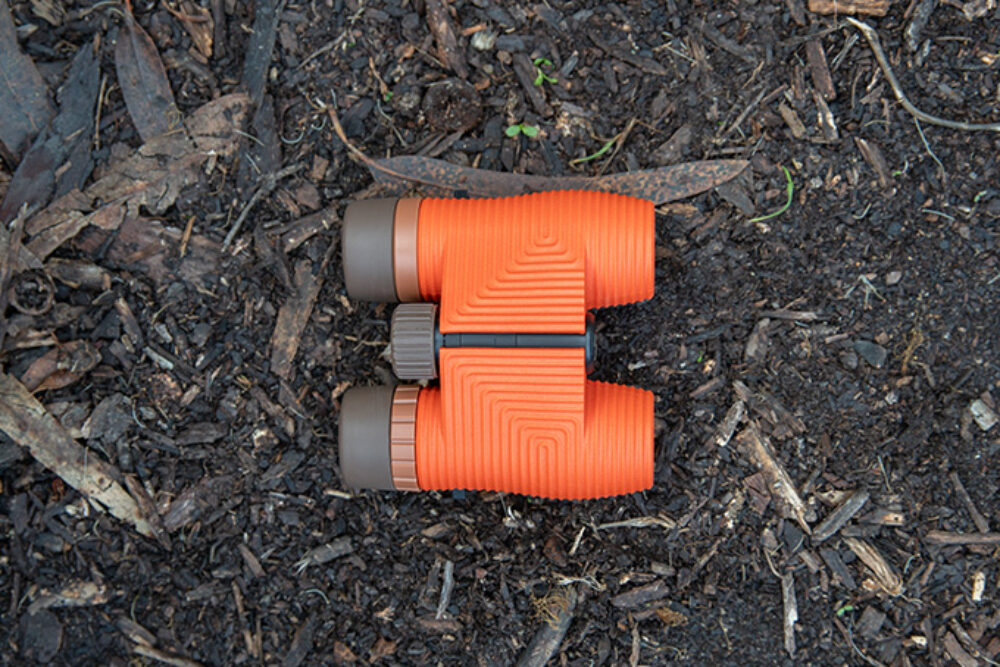
Pros
- Seriously great clarity for the price
- Attractive color options
- Lightweight and compact
- Grippy in hands
- Smooth focus knob
Cons
- Hard to use with glasses
- Narrow viewport may require more eye adjustment
Best Budget Binoculars: At just 4in long and 1lb in weight, these super low-profile specs from Nocs Provisions are the perfect budget binoculars for those who just want to keep something handy in case they spot the occasional buck or woodpecker. Capable of being submerged in water for up to 30min with IPX7 certification, this pair also comes built with a high-impact rubber grip that lets you whip it out in a hurry and stays durable against bangs and drops. The internal chamber is pumped with nitrogen to make these perfect for any weather and the GoodEye Glass system keeps the light from reflecting off the lenses.
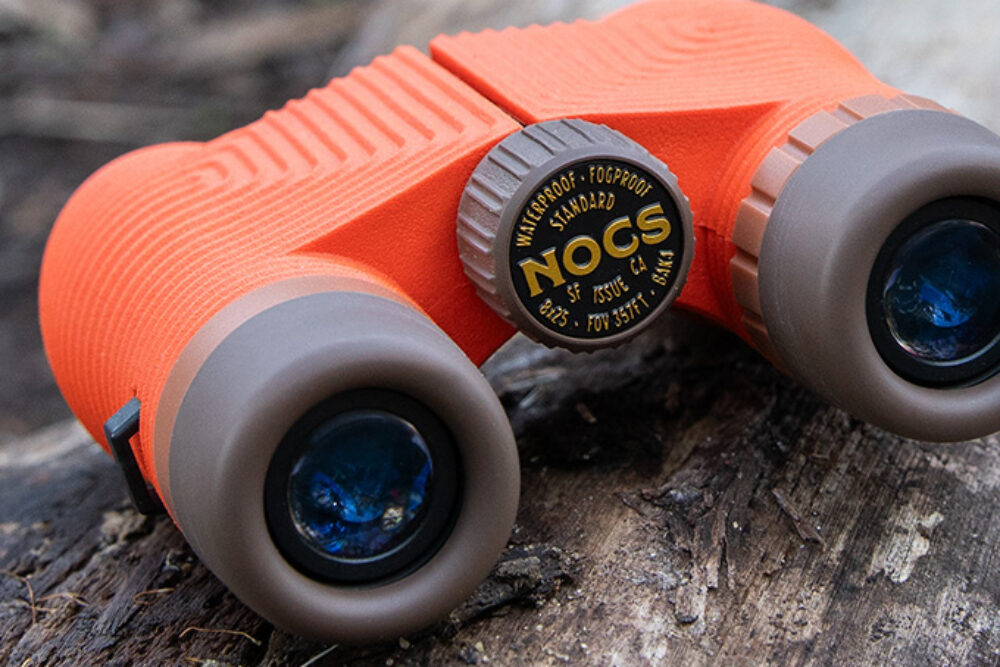
The first thing I noticed when comparing the Nocs to the other models on this list is how incredibly compact and lightweight this is. That’s not to mention how comfortable these fit in your hands, which I was surprised with considering the smaller size. Perfect for tossing in your bag before an outing, or leaving it in your hiking go-bag, the Nocs will easily hold up to any banging they’ll endure along the way. In terms of clarity, these binoculars will certainly get the job done when out and about, even if you won’t get as crystalline of an image as you would get with, say, Leica or Zeiss. I also loved how smoothly and gradually the focus knob operated, which may be slower for some trying to get a quick glance, but nonetheless prevented me from over-correcting the focus.
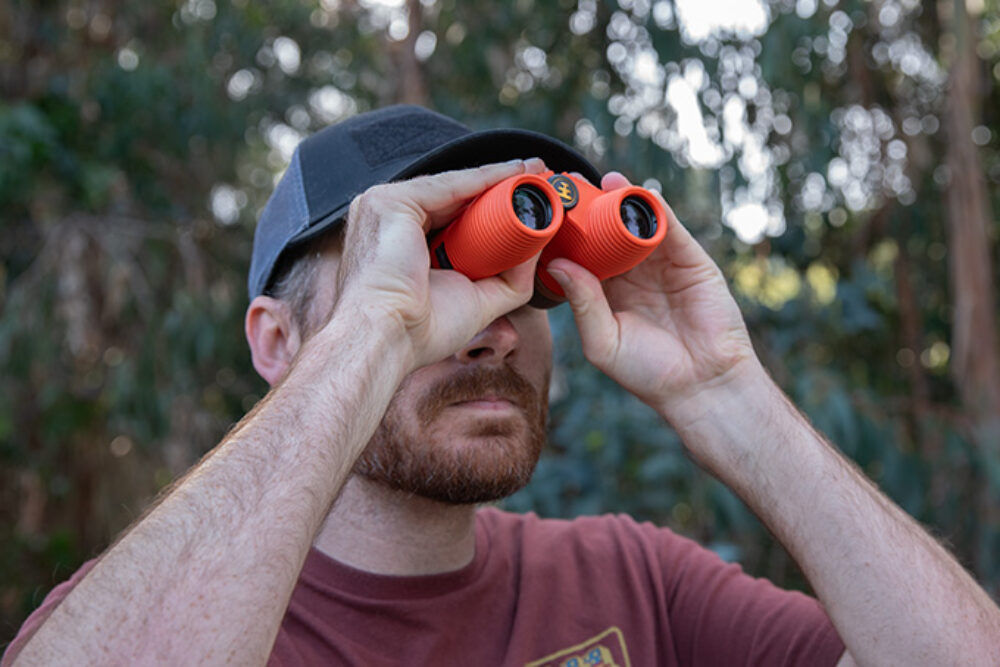
As for the drawbacks, there’s the aforementioned clarity discrepancy, which is to be expected on a $95 pair, even though these will get there’s nothing to complain about there. Also, the adjustable eye relief at the low end (7mm) was unusable for me without my glasses on due to the narrow viewing lens; I had to have the unit so far away that it became difficult to see. They can be increased to 13mm, which would have been fine with my glasses on had the lens diameter been a bit wider. On another note, the narrow port is good for taking pictures with your phone.
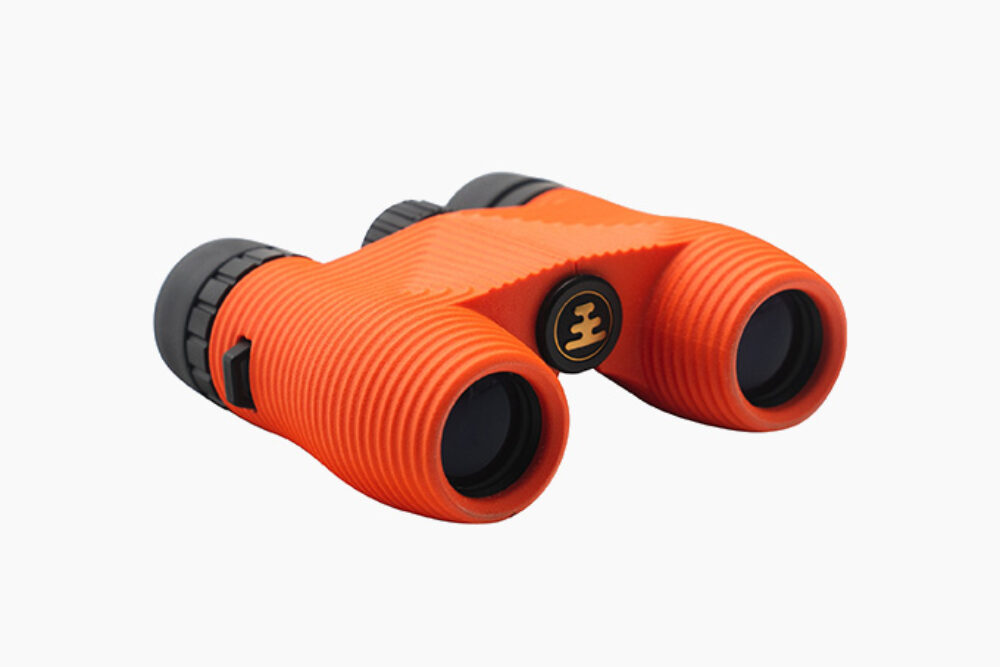
Verdict: Easily fitting into the cargo pocket of my pants, these make a convincing case for themselves when choosing which pair to bring on my next hiking venture. Durable and clear, these specs also have several attractive colorways for their recognizable design language. Especially if you’re a new user, the Nocs Standard Issue (the brand also has Field and Pro Issue models) is an accessible pair of binoculars in terms of both usability and price. If you don’t want to splurge yet on a $200+ pair, you should highly consider getting these.
Type: Porro
Exit Pupil: 3.1mm
Field of View: 357ft
Eye Relief: 7 to 13mm
Weight: 11.85oz
Celestron SkyMaster 15×70
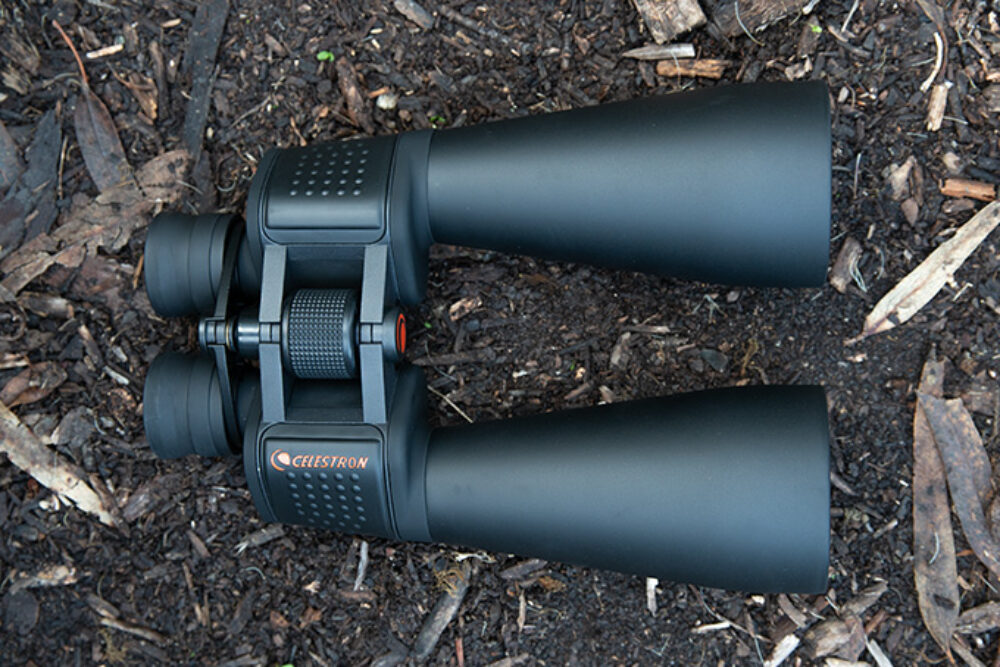
Pros
- Best stargazing binoculars you can find
- Works fine in city settings
- Allows you to see certain stars that you won’t see with the naked eye
- Split-focus feature for right eye doesn’t get in the way
Cons
- You’ll need a tripod for effective stargazing
- Stiff IPD adjustment
Best for Stargazing: When staring at the night sky for a significant amount of time through a telescope, keeping one eye closed can be annoying. If you want to be comfortable when stargazing, pick up the SkyMaster from a brand that specializes in nighttime viewing, with 15x magnification power for extra-long ranges and a wide exit lens that’s perfect for low-light conditions. Celestron’s flagship model has a good 13mm eye relief for users who wear eyeglasses and the 231-foot field of view makes these good for plains spotting as well. The SkyMaster also has a smartphone adapter available so you can save images through your binoculars.
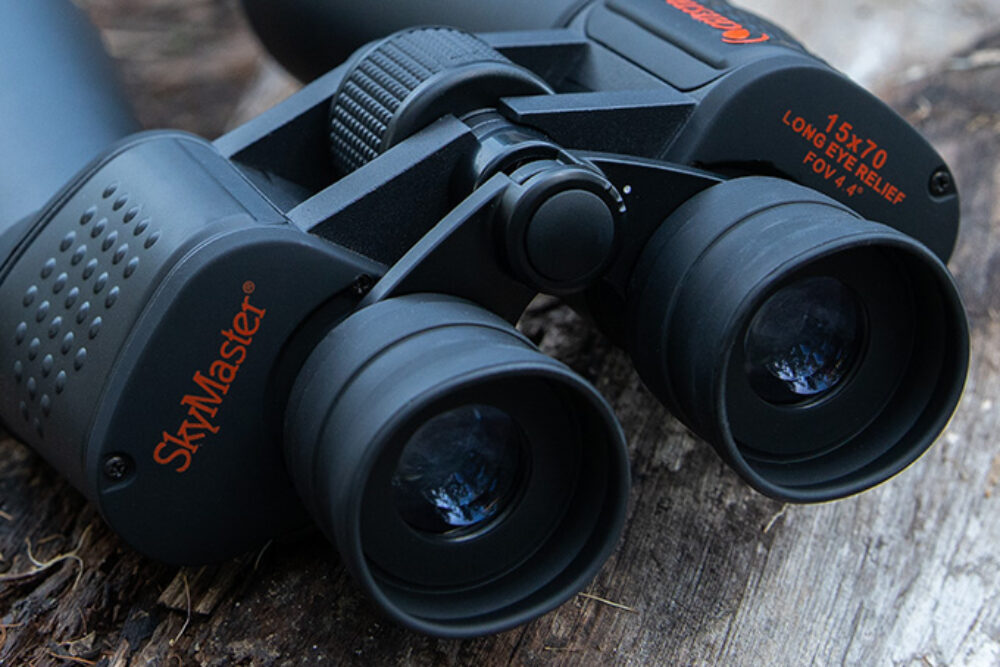
First off, when using any device to view nighttime objects, steadiness is key. As such, the SkyMaster will be virtually pointless without some sort of tripod. Fortunately, the binoculars easily accommodate such an attachment. Without them, stars and other objects will bounce around considerably in your view. Compared to the Pentax 3-in-1’s stargazing abilities, the SkyMaster performs really well in urban settings, even if there’s lots of ambient light. Even if you’re in a brighter area, it can allow you to view some harder-to-see stars and star clusters that aren’t necessarily visible to the naked eye. That’s not to mention the wide-ranging focus wheel and the split focus for the right eye, but with easy-to-read notches and a neutral “0” point for those who don’t need it.
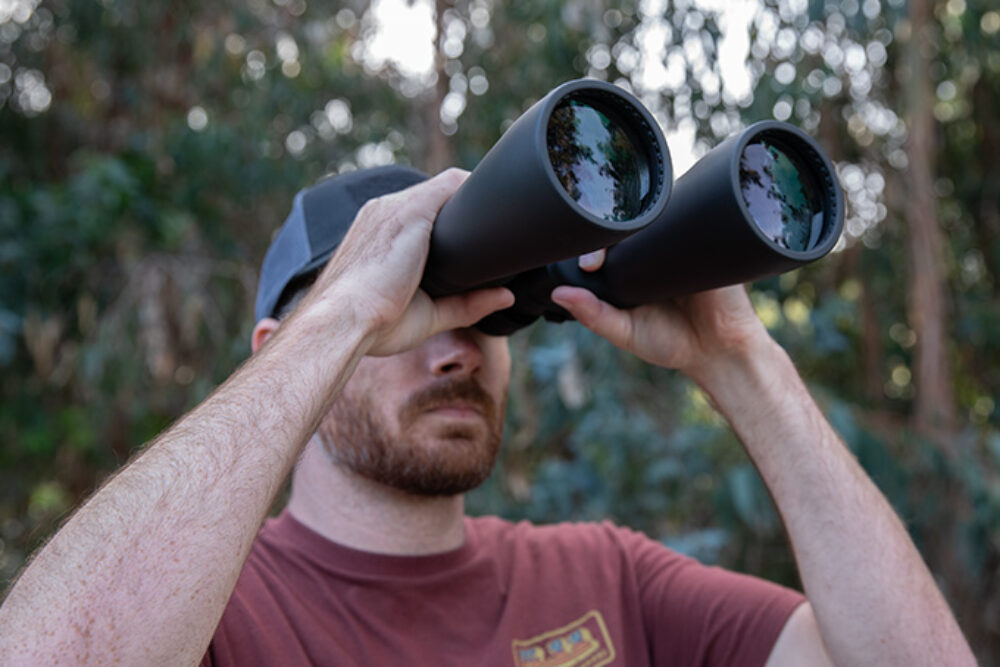
Before you’re able to enjoy any pros of these binoculars, you’ll instantly notice their large and heavy profile. Comically long, the SkyMaster’s hefty size furthers the point of why you need a tripod; the weight will cause these to wobble around too much in your hand. Another point of contention is the stiff interpupillary distance (IPD) adjustment, which is fine if you’re the only one using it but might get frustrating if you’re stargazing with others.
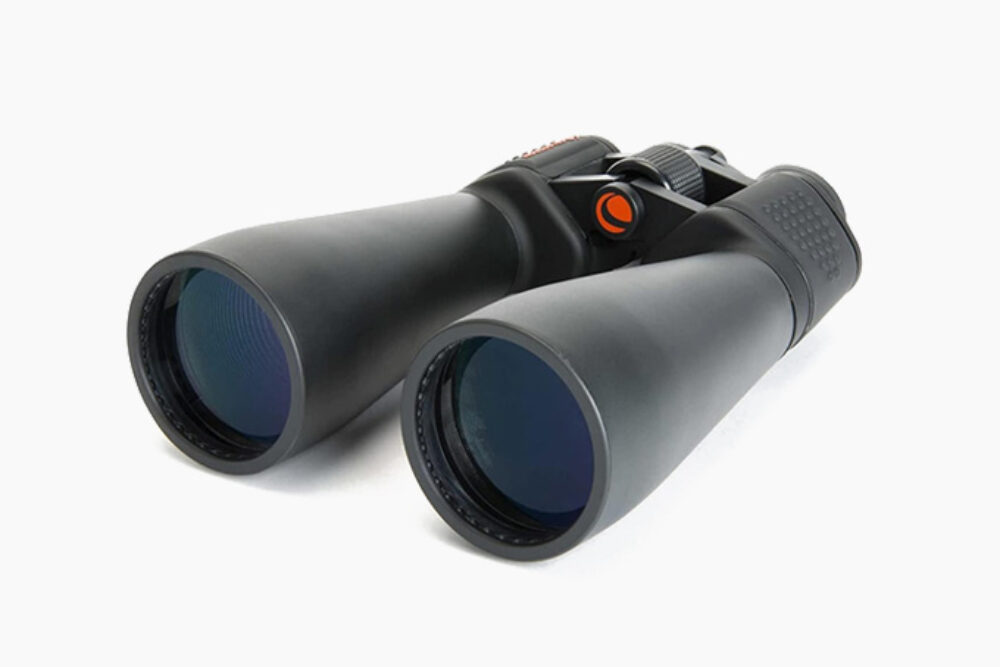
Verdict: Like with any stargazer, it’s inherently difficult to find your intended objects in the night sky with the SkyMaster, but it’s still much easier than it is with any other nighttime binoculars. Compared to the Pentax in its telescope mode, this pair by Celestron is the clear winner (the Pentax, however, can perform better as daytime binoculars). Perhaps not your first choice as standard, everyday binoculars, these are a solid supplementary piece of gear on any camping excursion. While a larger telescope will certainly be a better choice for viewing the sky at home, the SkyMaster is a better mobile or adventure unit for any occasion where you don’t want to lug around a giant telescope.
Type: Porro
Exit Pupil: 4.67mm
Field of View: 231ft
Eye Relief: 18mm
Weight: 48oz
Pentax 4×20 3-in-1
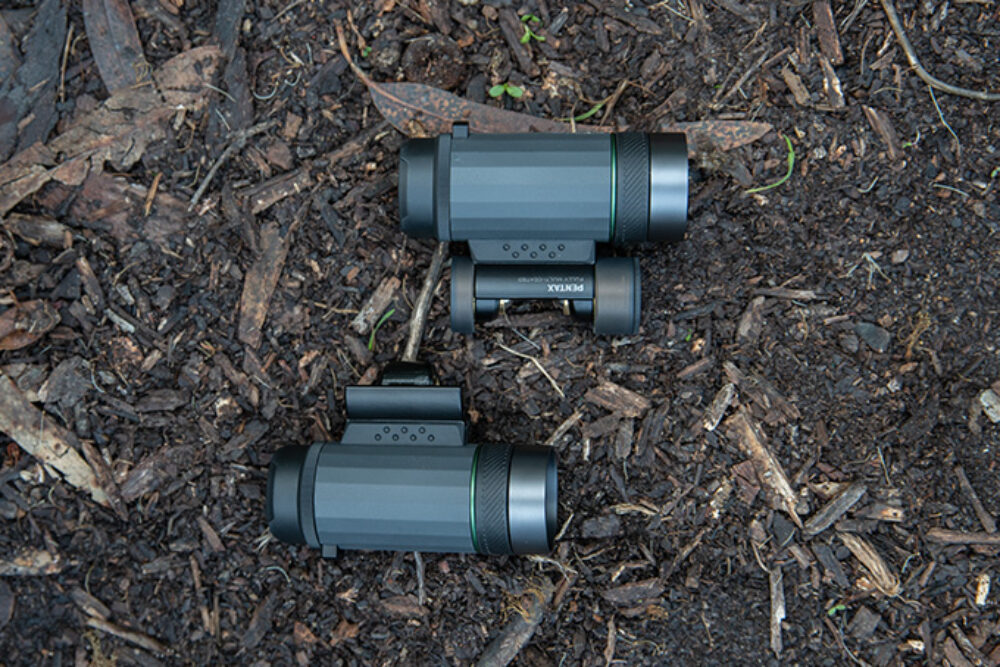
Pros
- Can be combined to become a telescope
- Close-focus range of 5ft
- Attractive aesthetic
- Feels nice in hand
- Extremely compact
Cons
- Dual focusing knobs can be frustrating to use
- Telescope mode feels like too much and is hard to use in city settings
- Can be difficult to separate the first few times
Most Versatile: The Pentax 3-in-1 consists of two 4×20 lenses that you can either use together as binoculars or split into 2 monoculars to share with whomever you’re with. However, if you want to do a bit of stargazing, the two individual monoculars can be combined as a telescope with 16x magnification (multiplying both 4x lenses). When used as binoculars, the 4×20 specs provide a generous exit pupil for clarity that many 8×42 lenses can’t hit while also having a close-focus range of just 5ft. With an improved roof prism system that uses anti-reflection multicoated optics, the contrast on these binoculars is evidence of the advancements in roof prisms in recent years.
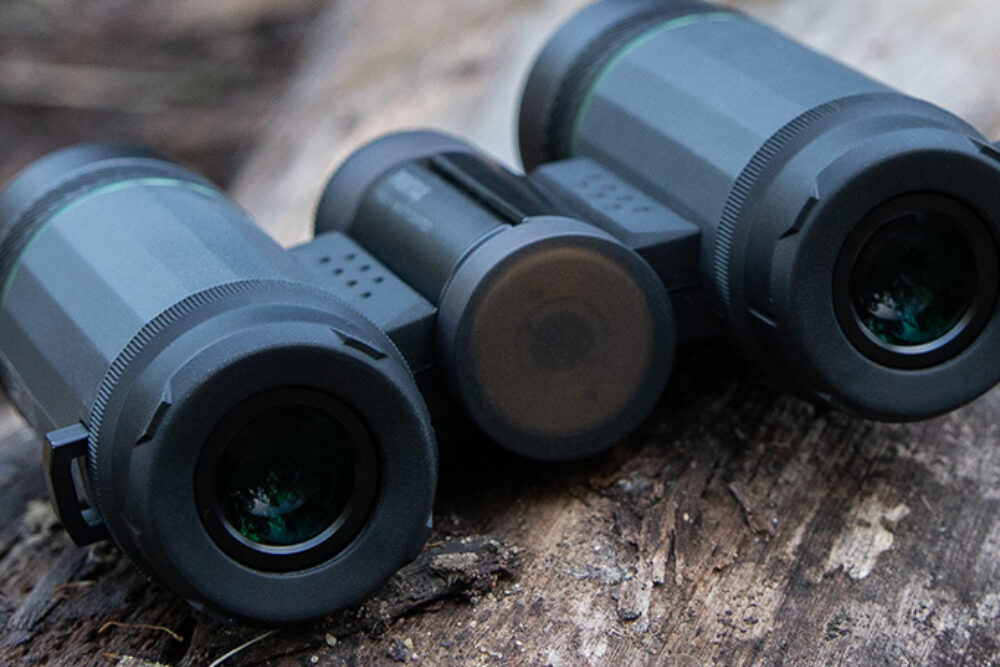
Instantly recognizable among the bunch, these Pentax specs have an attractive, almost Deco-esque aesthetic. Colored in gray, the housing features grooves along the side that feel great in your hands, with thumb imprints for good measure. These are also the most compact pair on our list (although the Nocs are slightly lighter in weight), which makes them excellent pocket options, although if you close them too far, they might accidentally separate, so keeping them in their case is recommended. With fantastic clarity and the aforementioned close-range capability, the 3-in-1 binoculars do bring some fun to the binocular world with their design as well, and even come with a tripod attachment point for steadier viewing, especially at night.
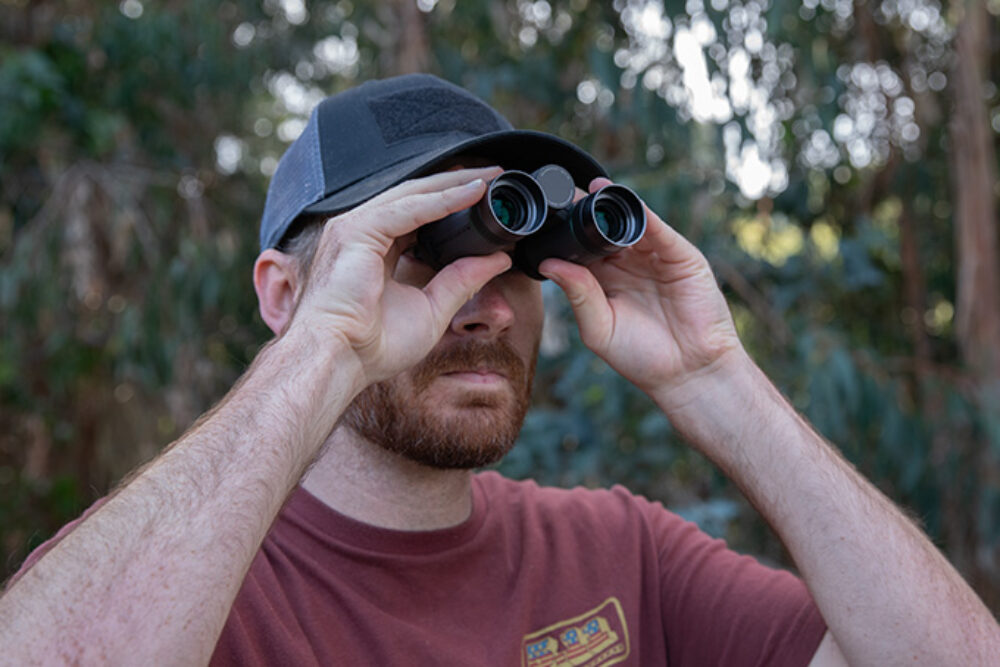
While they’re a lightweight, compact, and interesting pair of binoculars, the 3-in-1 potential may be a bit overkill. Even if you manage to wrestle apart the two sides of the unit, the “telescope” feature is frustratingly difficult to use and is really meant for larger nighttime objects such as nearby planets and the Moon. I live in a city with lots of ambient light and had to go to a more remote location in order to effectively stargaze with these, and even then, it was a bit difficult to keep the telescope steady free-handed. In terms of standard “binocular mode,” the Pentax can be frustrating when it comes to focusing since each side focuses separately from the other, which can admittedly be helpful if your eyes have two different acuities. I also found small notches that can be used to set each lens at the same spot, although these were difficult to interpret.
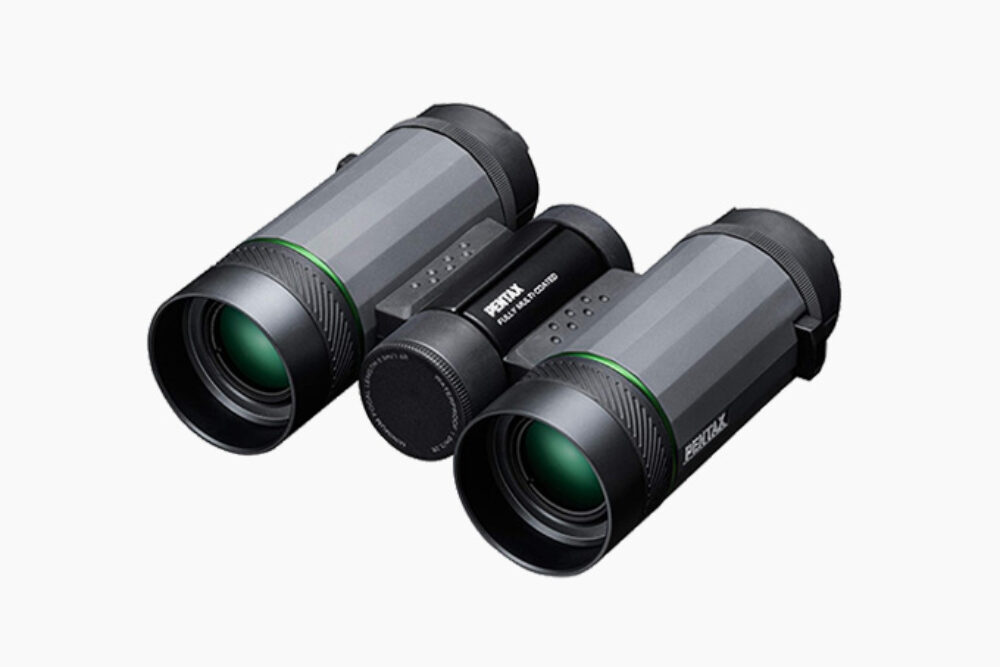
Verdict: These binoculars are not for everyone, but may still garner some fans. Our in-house photographer, who was also hands-on with these, enjoyed the Pentax a great deal. He was more familiar with firearm scopes and loved the monocular feature. If you can find a good deal on the Pentax 3-in-1, they can be a fun addition to your adventure loadout. And they look great on the shelf as well. The clarity is solid and they are insanely easy to lug around in your pocket. However, if you’re a serious binoculars user, you may want to look elsewhere since you may not be able to justify using these beyond their intended gimmick.
Type: Roof
Exit Pupil: 5mm or 1.25mm
Field of View: 525ft
Eye Relief: 19mm
Weight: 12.9oz
Nikon Monarch M5 8×42
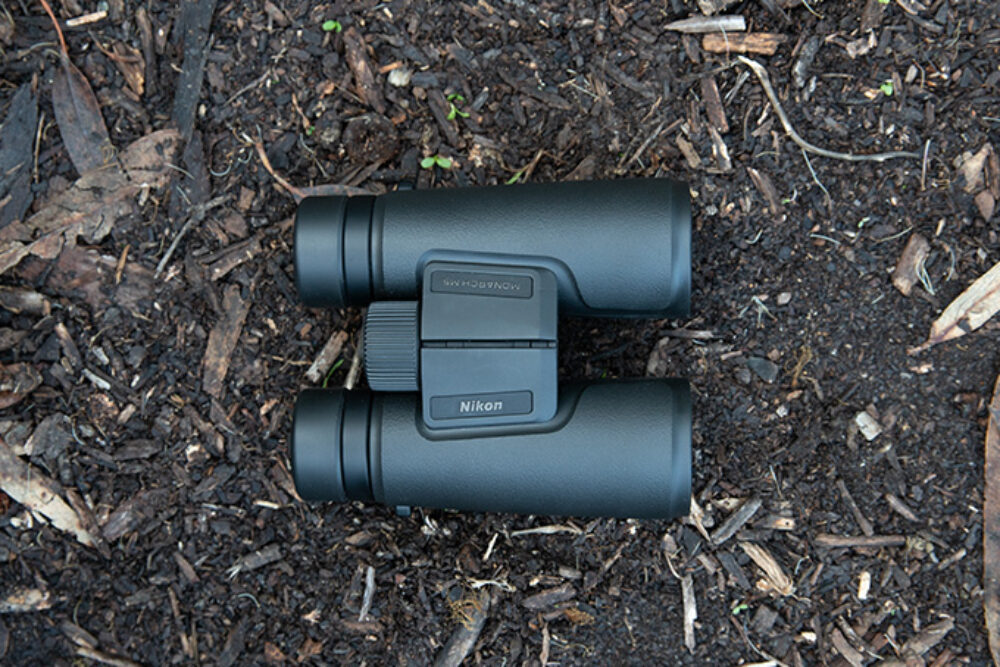
Pros
- Oil- and water-repellant eyepieces
- Affordable roof prisms
- Perfect size for your hands
- Nikon has some of the best lens glass
- Great intermediate model
Cons
- Noticeable clarity difference between this and Celestron Trailseeker, side by side
Best Overall: Simply the best overall binoculars you can buy, the Nikon Monarch M5 has earned its ubiquity. Not only are they easy to handle with their firm and shock-resistant grip, but these specs are companion-based for a personal experience thanks to the locking diopter control that saves your tailored settings each time you go to use them in order to lessen the time you’ll have to spend calibrating the barrels. Nikon’s proprietary extra-low dispersion glass is equipped on the objective lenses and eyepieces, which are also oil- and water-repellant.
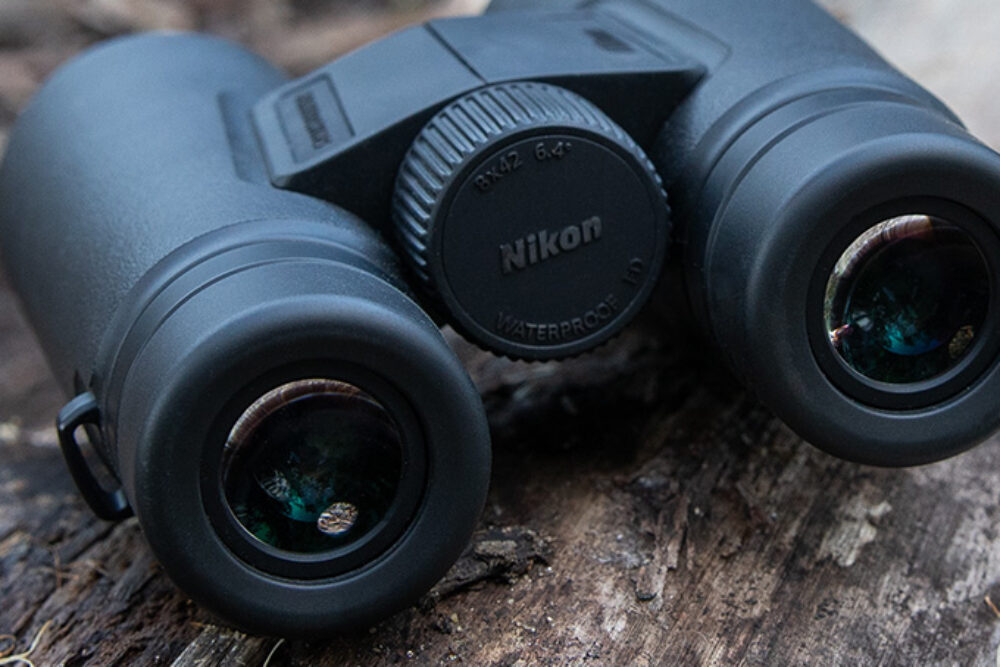
Compared to other high-end roof prism binoculars on the market –– some of which exceed the thousand-dollar range –– the M5s are extremely affordable, helping to put them at the top of our list. Very easy to use and adjust, these specs are lightweight (22.2oz) and are the perfect size for your hand without being too large. Compact binoculars are great but the tactility of slightly larger models has its value as well. The oil- and water-repellant eyepieces are a nice touch as well. We didn’t necessarily send our testing model through the ringer, but the specs feel very durable and the roof prisms will generally hold up better than a porro counterpart.
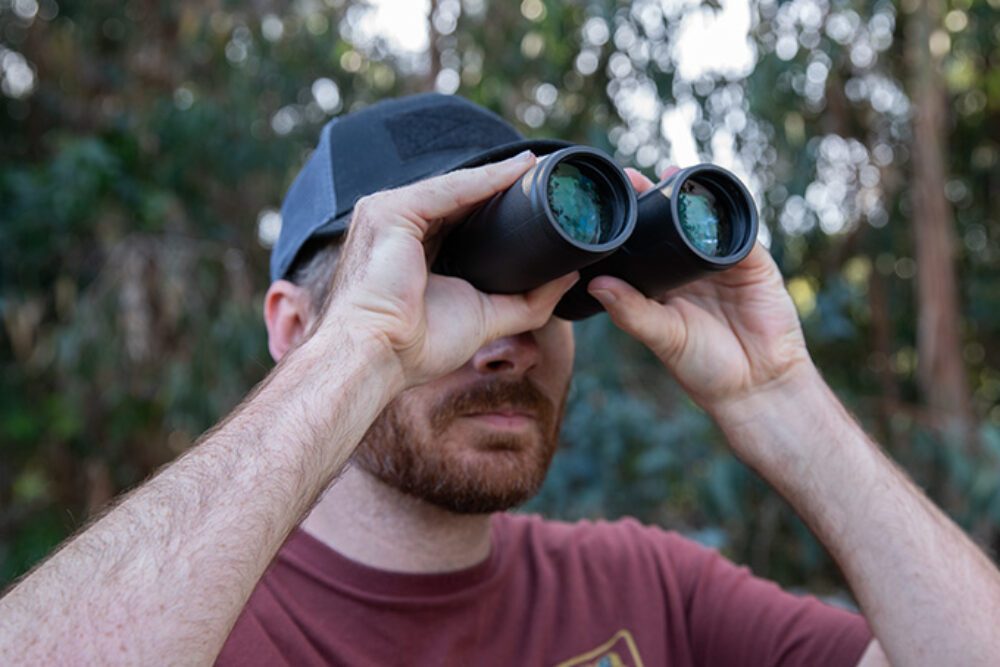
It’s not that the Nikon Monarch doesn’t have top-tier clarity, but when you’re comparing models side by side, you tend to notice things. Albeit more durable, roof prisms are typically not as clear as porros, but nonetheless, the Nikon will do its job perfectly, especially at under $300.
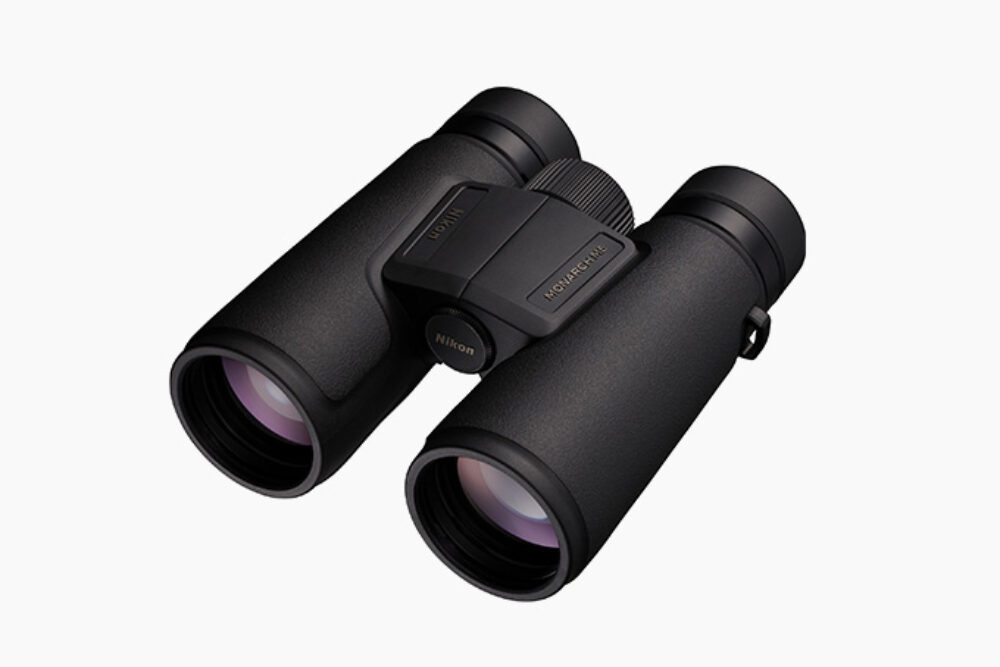
Verdict: A great pair for beginners or intermediate users, the Nikon Monarch M5 is the best for our money, albeit similar to the Celestron Trailseeker below. Either one will serve you very well, however, the Nikon may have a slight edge in durability and weight. They feel solid in-hand, and the soft coat on the housing only adds to that. If you want a more powerful model, Nikon also has a 10×42 pair called the Monarch M7 at a couple hundred dollars more.
Type: Roof
Exit Pupil: 5.3mm
Field of View: 335ft
Eye Relief: 19.5mm
Weight: 22.2oz
Celestron Trailseeker 8×42
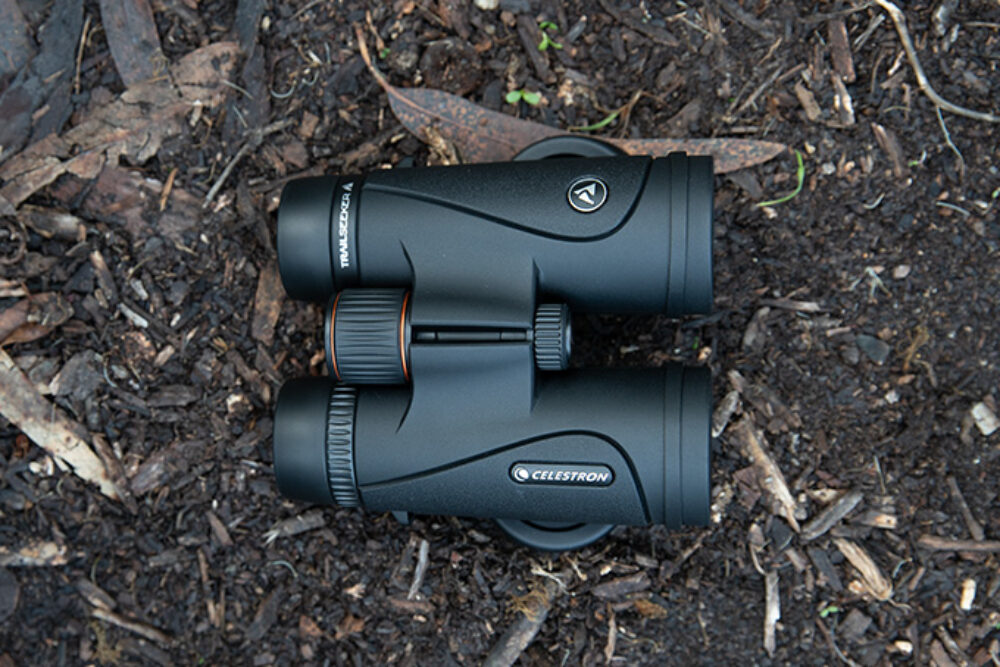
Pros
- Gives the Nikons a run for their money
- Durable and waterproof
- Feels great in-hand
- Nice clarity
- Great close-range capabilities
Cons
- Slightly pricey for beginners, but a great intermediate model
- IPD adjustment is stiff
Best for Hiking: Celestron has proved to be one of the most versatile binoculars brands in the game. Its Trailseeker is toward the top of the line as far as porros are concerned thanks to its BaK-4 prisms, which use superior glass material for incredible quality, enhanced even further with an anti-reflective and dielectric coating. The frame is made from magnesium alloy for incredible durability, lightness, and waterproofness, and is capped with metal eyecups that last much longer than plastic or rubber ones. With a 17mm eye relief, the Trailseeker is also perfect for users with eyeglasses but can be adjusted easily regardless.
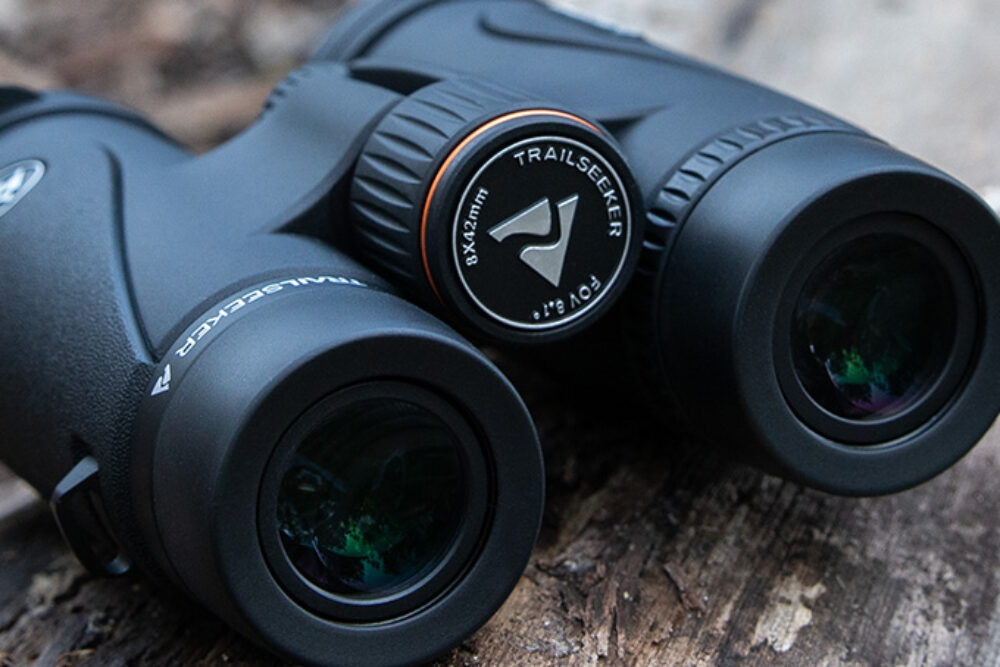
These are the most similar to the Nikon Monarch above, in terms of size, weight, even physical appearance, and honestly my verdict was very close. The Trailseeker improved on things such as lens clarity (in part thanks to the porro prisms over the roof prisms of the Nikon) and the tactility of in-hand feel, which could provide some extra grip in certain outdoor conditions. Likewise, the close-range feature is nice on the Celestron, as is how straightforward it is to use. There’s also a tripod attachment point on the front, which can be useful for those taking in wildlife.
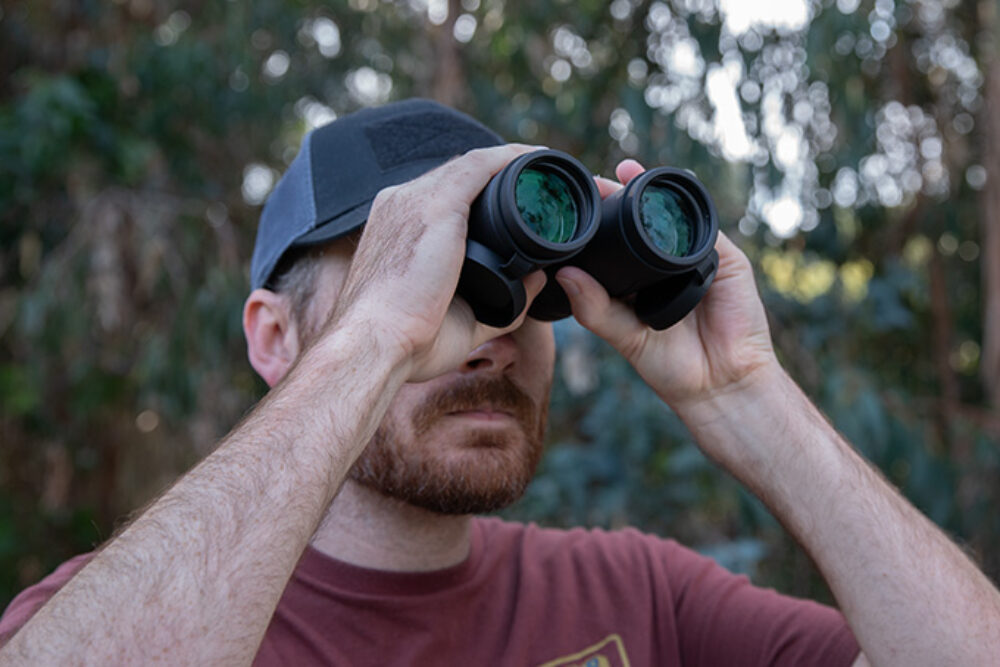
There weren’t many downsides to the Trailseeker, other than the relatively steep price for porro binoculars. This model is a highly attractive beginner’s unit but few beginners will want to pay upwards of $300 for their first pair. However, I did happen to notice the stiffness of the interpupillary distance adjustment, which may get annoying when sharing with a friend. These are slightly heavier than the similar Nikon M5s above due to the porro prisms, but perform relatively similarly.
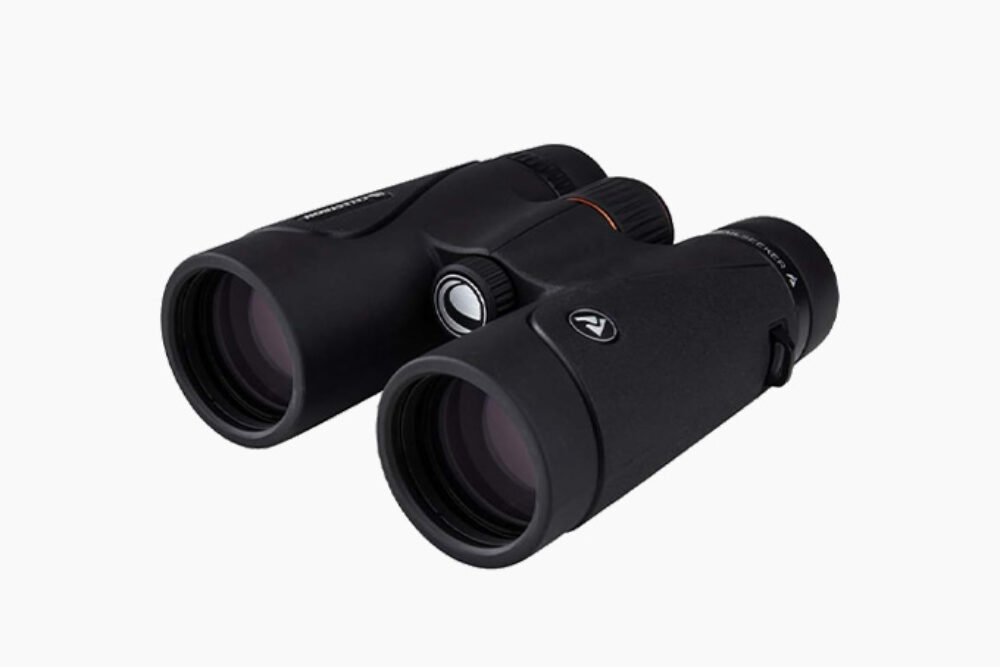
Verdict: Waterproof and durable, these binoculars are a solid outdoor companion can likely take a relative beating in your backpack or around your neck. All in all, you could make a case that the Celestron Trailseeker are the best binoculars out there, especially when considering clarity, the claimed durability, and just how straightforward it is to use them. However, the price could be about $50 to $100 cheaper and it would have made the top of our list.
Type: Porro
Exit Pupil: 5.25mm
Field of View: 426ft
Eye Relief: 17mm
Weight: 23.1oz
ZEISS Victory HT 10×54
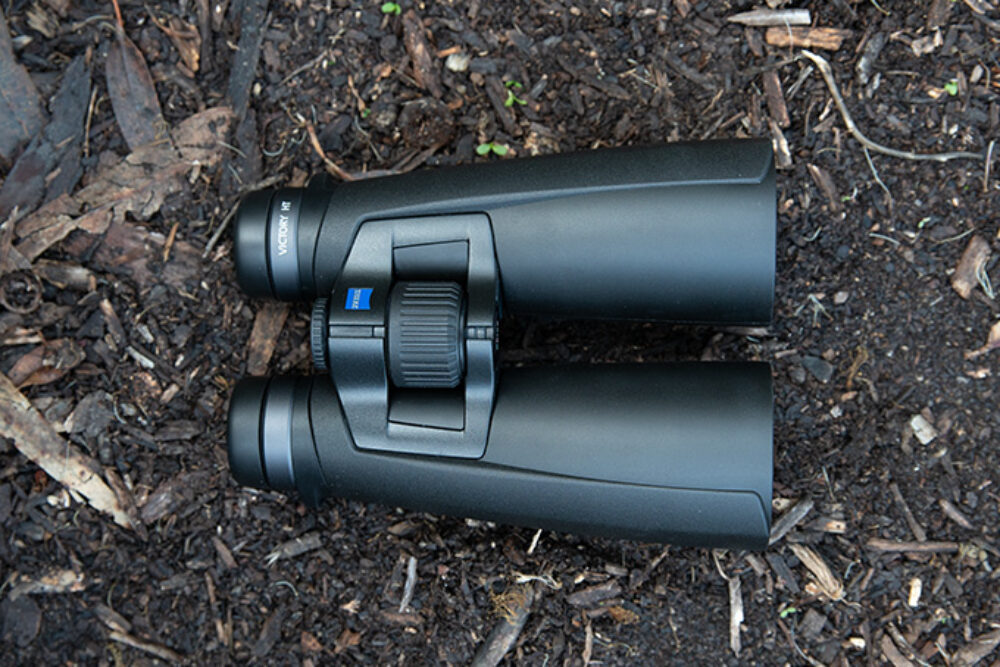
Pros
- Great for long-range
- Great for both daytime outdoor activities and night hikes
- Durable
- Has diopter adjustment to change depth-of-field
Cons
- Expensive
- Relatively bulky
- Diopter adjustment could be more user-friendly
Best for Low Light: Where most binoculars go out of commission as the sun begins to set, the excellent exit pupil and objective lens diameter on the ZEISS Victory make it one of the best models for twilight time, but these specs are superb any way you slice them. Dustproof and waterproof to last you a long time, the binoculars are also equipped with the enhanced ZEISS T* coating for superior color and contrast, with a field of view of 330ft. While the 8×54 version has one of the highest fields of views we’ve seen (427ft) for an ultimate widescreen depiction, this 10×54 companion is much more effective in low light.
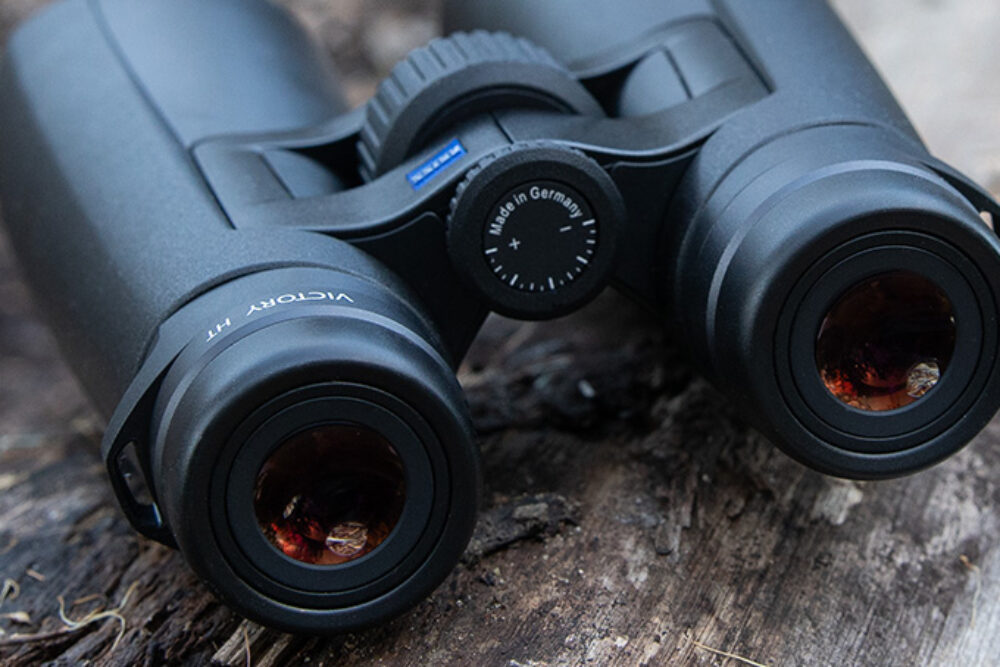
As the model suggests, these Zeiss binoculars can hit super long-range distances, and in low light nonetheless, which can be beneficial when glimpsing owls, deer, and other nocturnal animals that arrive in twilight time. But what makes the Victory so special is how fantastic it performs as your everyday go-to specs. With the immaculate clarity you’d expect from Zeiss, these binoculars can be helpful when checking in hilltop views, or views of the hilltop. Likewise, the focus knob on this is nice and gradual for honing in that sweet spot. This is bolstered by the addition of a diopter control, which allows you to adequately change the depth-of-field of your focal point (think of this as Portrait Mode on your iPhone).
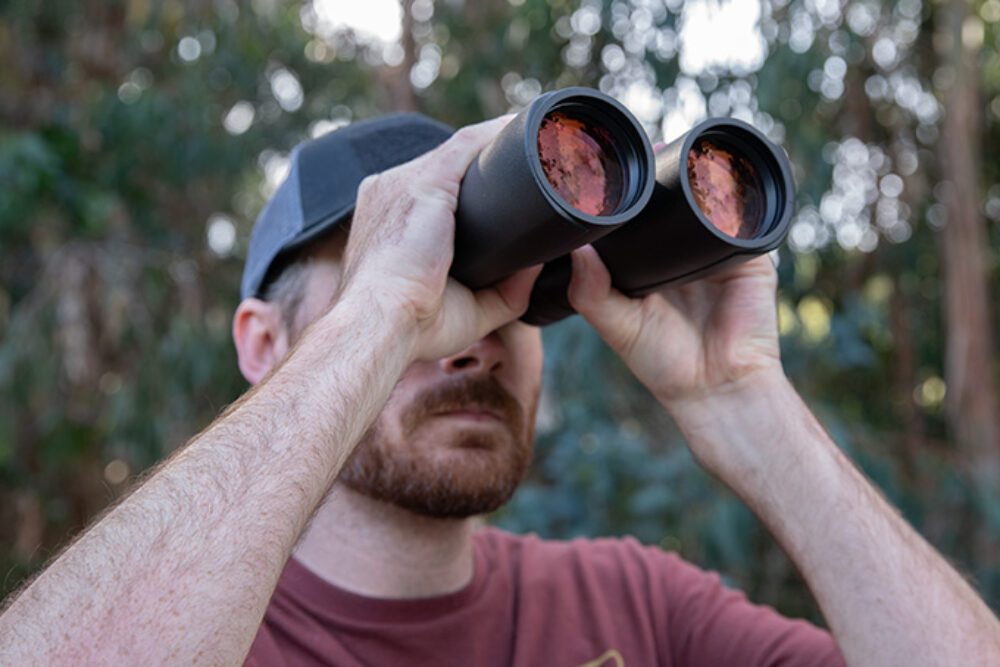
Aside from the SkyMaster above, the Zeiss Victory is the largest binocular on this list. And while they may be a bit bulky for the casual camper, they’re relatively lightweight considering, and won’t be cumbersome to toss in your backpack (NOTE: We do not recommend “tossing” a $3,000 pair of binoculars). The biggest downside, other than the steep price, is the diopter adjustment. Compared to the diopter control on the Leica down below, the one on the Zeiss is not as straightforward, and can “only” get about 40ft in close range, certainly due to its capabilities in long range.

Verdict: Listen, if you’re going to spend three grand on a pair of binoculars, you have a choice between the Zeiss and the Leica, and your deliberation will simply consist of how you’re going to use them. Both are exceptional and the comparison in features is marginal, but the Zeiss Victory will be your choice for outdoor activities such as hiking, backpacking, or mountaineering –– especially at night.
Type: Roof
Exit Pupil: 5.4mm
Field of View: 330ft
Eye Relief: 16mm
Weight: 37oz
Leica Noctivid 8×42
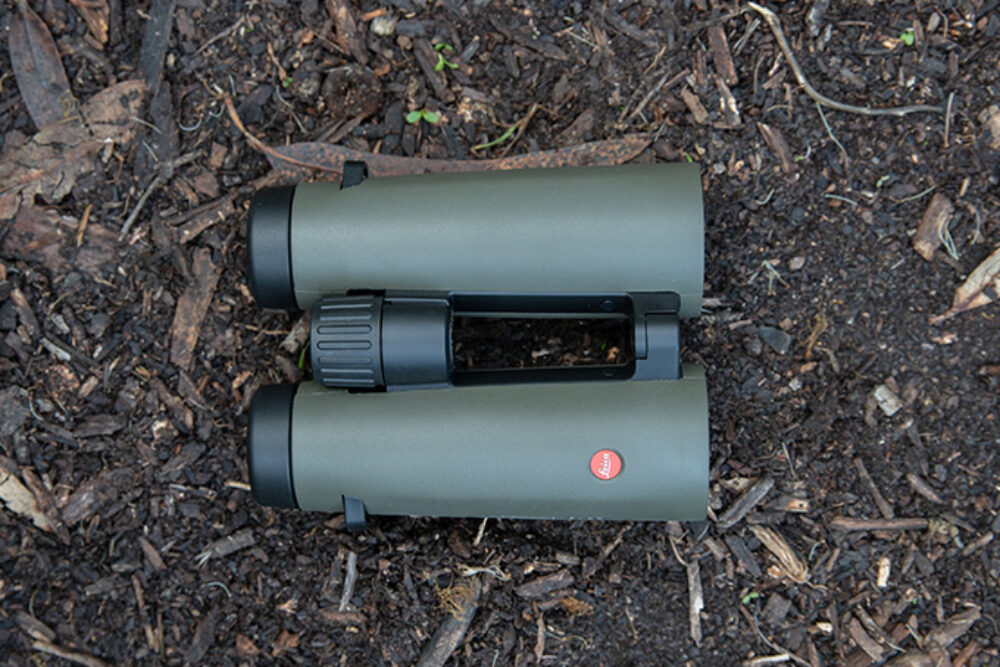
Pros
- Insane clarity and color contrast
- Intuitive design
- High field of view and estimated 10ft of close-range view
- Well-balanced focus knob
- Has diopter adjustment to change depth-of-field
Cons
- Expensive
- Negligably heavy
Best Upgrade: It’s no secret that Leica makes some of the best cameras in the world, but few are privy to its binocular expertise. While both the company’s Ultravid and the Trinovid models are fantastic, the Noctivid is our favorite due to the whopping 406-foot field of view and the unbelievably comfortable frame. Available in both 8×42 and 10×42 versions, with the former minimizing the weight of these already-heftier specs, the lenses are made from 100% Schott high-transmission glass and constructed with 12 different elements for extremely accurate color depiction and clarity.
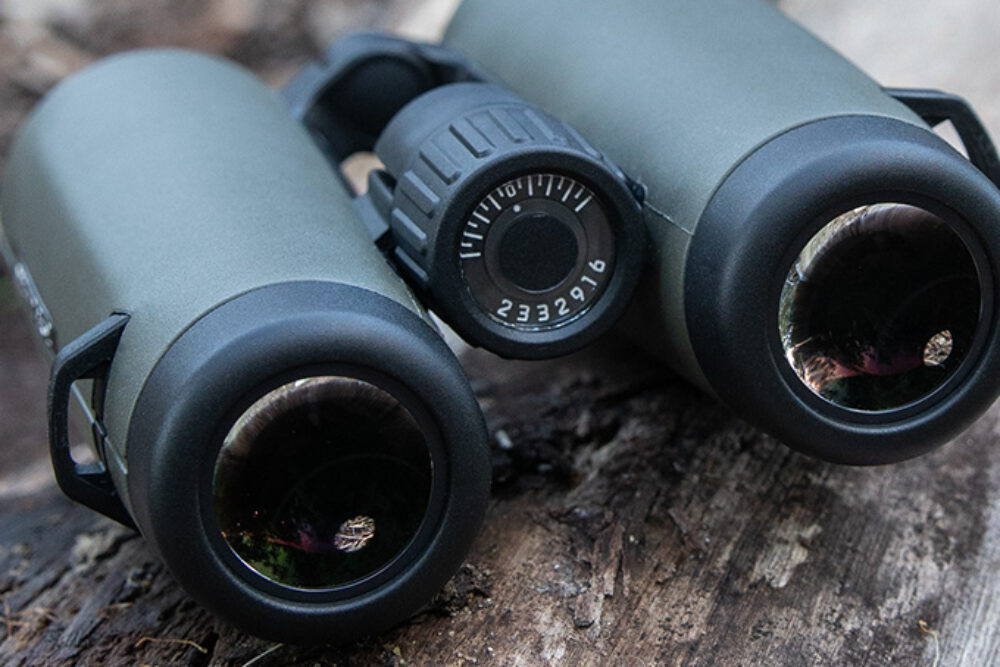
For our purposes, we opted for the 8×42. The first thing that stood out to me is the clarity, which is noticeably a tier or two above the sub-$1,000 models. I also liked the larger diameter of the viewing lens, which doesn’t decrease your frame when held slightly away from your face. The diopter adjustment is really straightforward to use and can get you images as close as 10ft away (although we’re not sure why that would be necessary). As for the focus knob, it balances graduality and smoothness better than any other binoculars on this list.
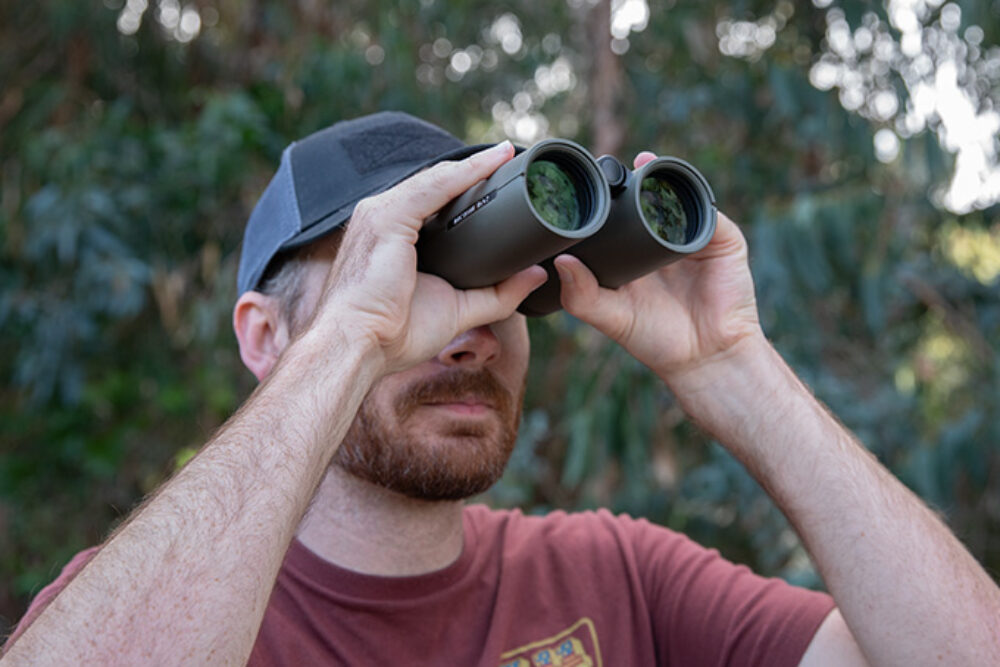
When spending thousands of dollars on a pair of binoculars, there won’t –– and shouldn’t –– be too many flaws. And that’s certainly the case here. Sure, the unit is surprisingly heavy considering its compact size and the eye relief adjustment is relatively stiff, but these are mere quibbles.
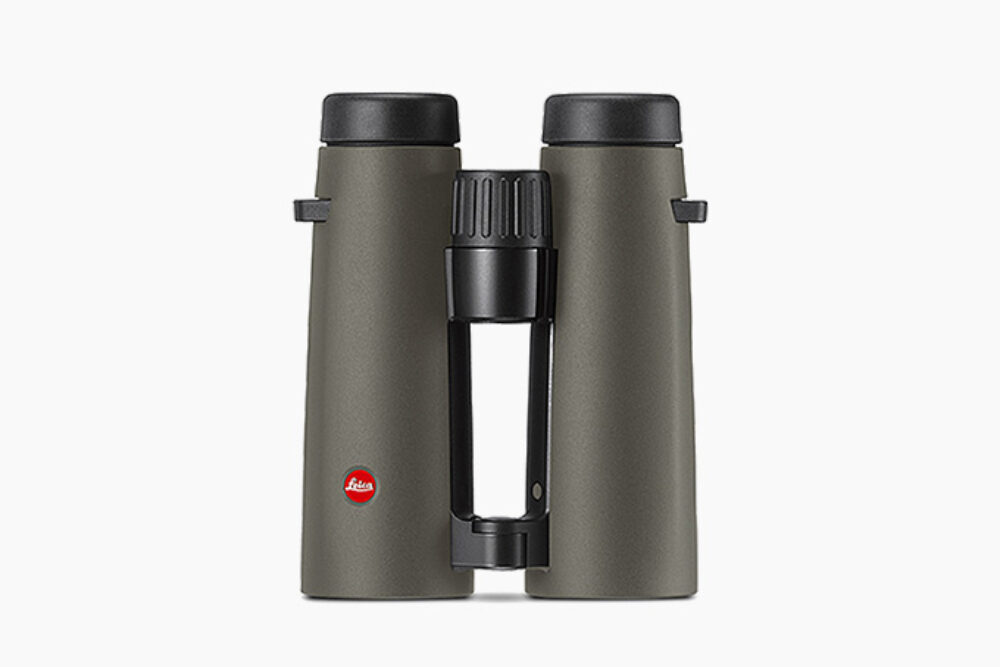
Verdict: Like the Zeiss specs above, the Leica Notctovid is quite expensive, to say the least. However, if you’re looking for the best everyday binoculars, regardless of price, these are your best bet. You get crystal-clear viewing, intuitive usability, and some of the best all-around specs you can find. Leave it to the camera icons to make pristine specs like these.
Type: Roof
Exit Pupil: 5.25mm
Field of View: 406ft
Eye Relief: 19mm
Weight: 30.3oz
Binoculars Comparison Chart
| Model | Price | Type | Exit Pupil | Field of View | Eye Relief | Weight |
|---|---|---|---|---|---|---|
| Nocs Provisions Standard Issue 8×25 | $95 | Porro | 3.1mm | 357ft | 7 to 13mm | 11.85oz |
| Celestron SkyMaster 15×70 | $106 | Porro | 4.67mm | 231ft | 18mm | 48oz |
| Pentax 4×20 3-in-1 | $221 | Roof | 5mm or 1.25mm | 525ft | 19mm | 12.9oz |
| Nikon Monarch M5 8×42 | $287 | Roof | 5.3mm | 335ft | 19.5mm | 22.2oz |
| Celestron Trailseeker 8×42 | $300 | Porro | 5.25mm | 426ft | 17mm | 23.1oz |
| ZEISS Victory HT 10×54 | $2,900 | Roof | 5.4mm | 330ft | 16mm | 37oz |
| Leica Noctivid 8×42 | $2,390 | Roof | 5.25mm | 406ft | 19mm | 30.3oz |
AI Integration & The Future Of Binocular Technology
With artificial intelligence being the talk of the year in 2023, the technology has already hit the world of binoculars, but beneficially. Where advancements in the binoculars space may move slowly, the addition of AI in Swarovski Optik’s AX Visio has thrown the pebble much farther than we’ve ever seen it thrown before. Designed by industrial design icon Marc Newson, who took inspiration from Swarovski’s historic Habichi models, the new specs cost nearly $5,000 but can spot over 9,000 different species of birds and wildlife in real time. From there, the information is sent to your phone to be logged in the app. The binoculars also act as a camera to shoot photos and video. The best part is that this is just the first step in a new chapter for outdoor optics. Who knows the capabilities that this new technology can and will have in the future?
Honorable Mentions
If you’re going to spend $300+ on a pair of binoculars, the Athlon Optics Midas 8×42 is a good choice, but not as capable or durable as the Celestron Trailseeker above, with the same specs and price, but utilizing a higher-clarity prism.
If your budget is a little higher, the Vortex Optics Viper HD 10×42 is another solid option as far as roof prisms go, especially if you’re looking for higher eye relief. However, at $500, these may not be quite as good of an all-around option as some of the less expensive models in this guide.
Like the others, the Canon 10×42 L is a good model –– and from an iconic brand nonetheless –– but the fact that there are other better high-end options at the same or lesser price, it was hard to justify including it here.
And then there’s the Swarovski Optik 10×42 EL, arguably one of the best high-end options out there. However, we had a tough time securing a model for hands-on testing and thus couldn’t include a full review here. It’s important to note the roof prism model’s incredibly clear contrast thanks to the in-house Swarovision tech, as well as the ergonomic grip and non-slip diopter control for hassle-free precision finding. If you’re an experienced user, you may want to consider these
The Best Hiking Boots for Men

If you’re planning on using your binoculars outdoors and need some solid shoes to get you off the grid, then check out our guide to the best hiking boots for men.








